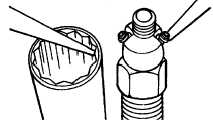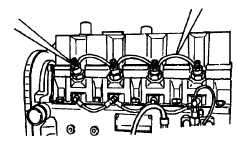| |
TM 10-3930-671-24
Section 8 - Engine Repair & Overhaul
This section includes instructions for repairs and
overhaul of the component units of Continental industrial
diesel engines.
Provide a clean place to work and clean the engine
exterior before you start disassembling-dirt causes
engine failures.
Many shop tools have been developed to save time and
assure good workmanship; these should be included in
your equipment.
Use only genuine Continental parts in Continental
engines since years of development and testing have
gone into these specifications to assure maximum life
and performance.
CYLINDER HEAD
The cylinder head is the most important part of the
engine
assembly
since
it
contains
the
complete
combustion chamber including valves, fuel injection
nozzles, glow plugs, and cored passages for air, exhaust
and water flow.
Removing the Cylinder Head
1.
Drain water from engine and disconnect radiator
or heat exchanger hoses.
2.
Remove cylinder head cover by removing the
cap screws holding the cover to the cylinder
head.
3.
Remove rocker arm shaft assembly and push
rods. Grip the push rods and snap them
sideways out of the tappet sockets as shown in
the illustration. This method serves to break the
hydraulic connection and permits lifting the push
rods out and leaving the tappets in place.
4.
Disconnect the injectors and leak-off lines at
both the nozzle and pump connections.
Removing Push Rod from Ball Socket of Tappet
Socket Relief Clearance
Caution should be used when replacing the fuel injectors
to prevent loosening the injector leak-off nipples.
Be sure to cut a relief in the inside of your socket for
clearance. This will prevent an interference between the
socket and the leak-off nipple.
Disconnecting Injector Leak-off Line
CAUTION
Always
cover
openings
with
protective caps at any time when
lines are disconnected. This will
prevent any dirt or foreign matter
from entering.
5.
Remove injection nozzle assemblies. Place a
protective cap over ends of injector for keeping
openings clean. Refer to fuel injection system
for testing procedures.
F-167
|





